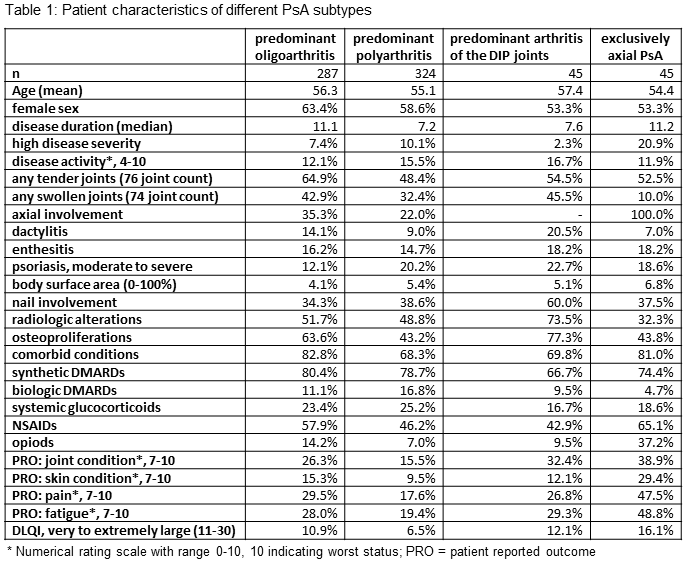Session Information
Date: Sunday, November 8, 2015
Session Type: ACR Poster Session A
Session Time: 9:00AM-11:00AM
Background/Purpose: Psoriatic arthritis (PsA) divides into different subtypes, of which polyarthritis and spondylitis would be expected with the highest disease severity. We compared disease burden in PsA patients with oligo- and polyarthritic subtype in the national database of the German Collaborative Arthritis Centres.
Methods: We added a specific PsA module to the standard documentation of the national database of the German arthritis centres, containing data on the predominant PsA subtype (according to physicians’ decision), associated skin, joint and other musculoskeletal manifestations. In addition to the Dermatology Life Quality Index (DLQI 0-30), patients reported specific questions concerning PsA-related disease burden. Between 2007 and 2013, in total 707 patients were documented.
Results: PsA patterns comprised 41% oligoarthritis (OA), 46% polyarthritis (PA), 6.4% arthritis of the distal interphalangeal joints (ADIP) or exclusively axial PsA (aPsA) each, and 0.8% patients with dominant arthritis mutilans. Age was comparable between all groups; female proportion was highest in OA. Disease severity was assessed by the physician as highest in aPsA, disease activity as highest in PA and ADIP. Focussing on OA and PA, joint and axial involvement, dactylitis, osteoproliferations and comorbid conditions were more frequent in OA, while psoriasis severity was higher in PA. OA was less often treated with biologics, while use of NSAIDs and opioids was higher than in PA. Patient reported outcomes (PRO) were worse in OA with regard to joint and skin conditions, pain and fatigue. When matching OA and PA by disease duration and gender (n=222 pairs with similar age, data not shown), disparities in physician’s disease assessment and PROs as well as treatment differences persisted. In addition to the higher comorbid burden, current regular smoking was more frequently seen in OA patients (23% vs. 16%).
Conclusion: Despite comparable disease activity and severity measured by clinical examination PsA patients with oligoarthritic compared to polyarthritic subtype show a higher patient reported disease burden, which has to be further examined. Optimising therapy, incorporating comorbidities and councelling the patient against smoking may bear potential to further improve quality of life in PsA-OA.
To cite this abstract in AMA style:
Huscher D, Albrecht K, Bischoff S, Thiele K, Behrens F, Fischer K, von Hinüber U, Späthling-Mestekemper S, Wassenberg S, Zink A. Patients with Psoriatic Arthritis and Oligoarthritic Subtype Report Higher Disease Burden Than Patients with a Polyarthritic Pattern – Data from the German Collaborative Arthritis Centres [abstract]. Arthritis Rheumatol. 2015; 67 (suppl 10). https://acrabstracts.org/abstract/patients-with-psoriatic-arthritis-and-oligoarthritic-subtype-report-higher-disease-burden-than-patients-with-a-polyarthritic-pattern-data-from-the-german-collaborative-arthritis-centres/. Accessed .« Back to 2015 ACR/ARHP Annual Meeting
ACR Meeting Abstracts - https://acrabstracts.org/abstract/patients-with-psoriatic-arthritis-and-oligoarthritic-subtype-report-higher-disease-burden-than-patients-with-a-polyarthritic-pattern-data-from-the-german-collaborative-arthritis-centres/

